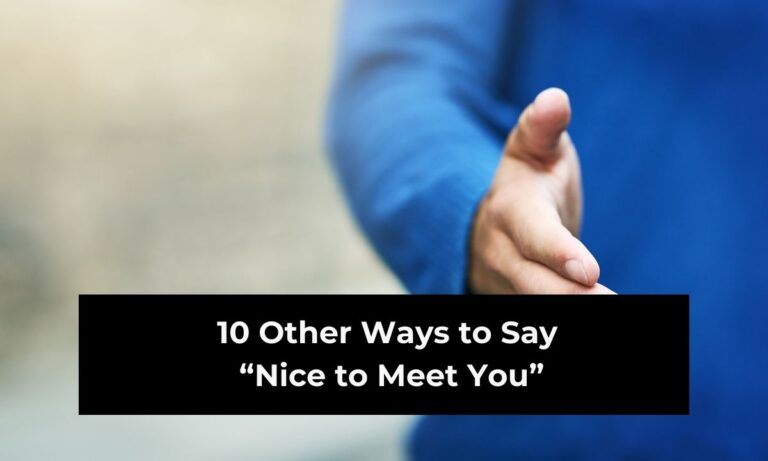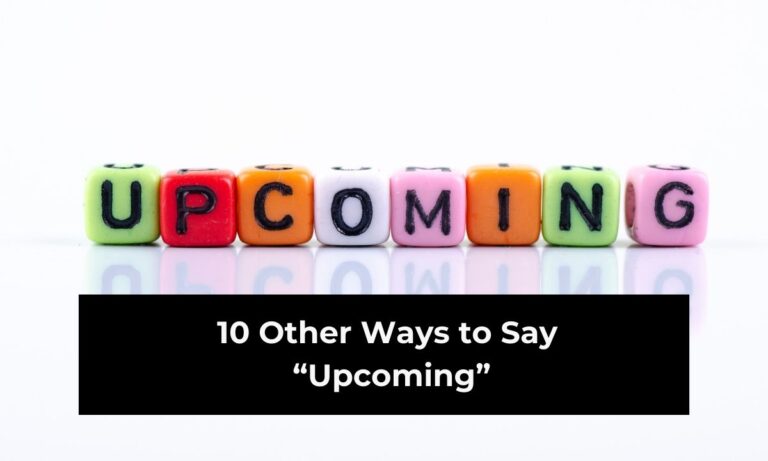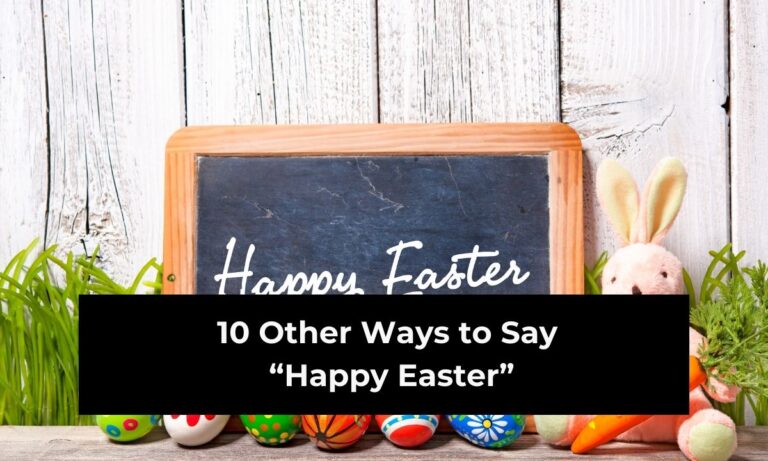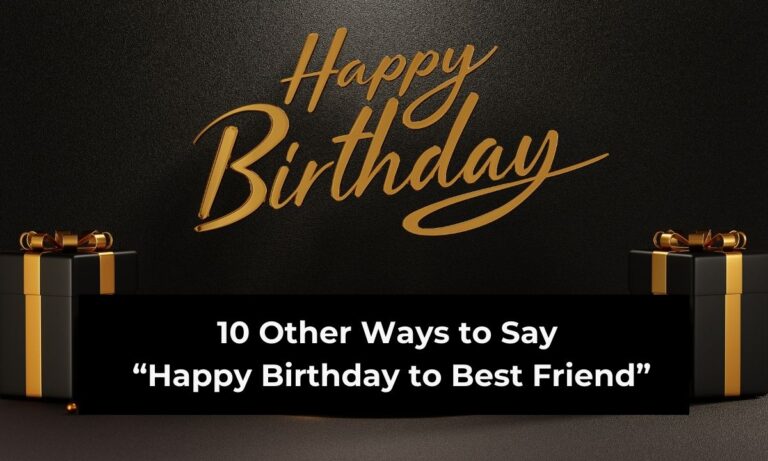When you’re connecting with someone online for the first time, it can feel a little awkward to find the right words. You want to sound warm, professional, and approachable—without being too formal or stiff. That’s why so many people default to saying “Nice to e-meet you.” It’s simple, polite, and easy to use in an email or LinkedIn message.
But here’s the thing: because it’s so common, it can come across as generic or overused. If you really want to stand out and make a positive impression, it helps to have other phrases ready to use. Whether you’re networking, interviewing, collaborating, or just meeting someone virtually, choosing a fresh alternative shows thoughtfulness and personality.
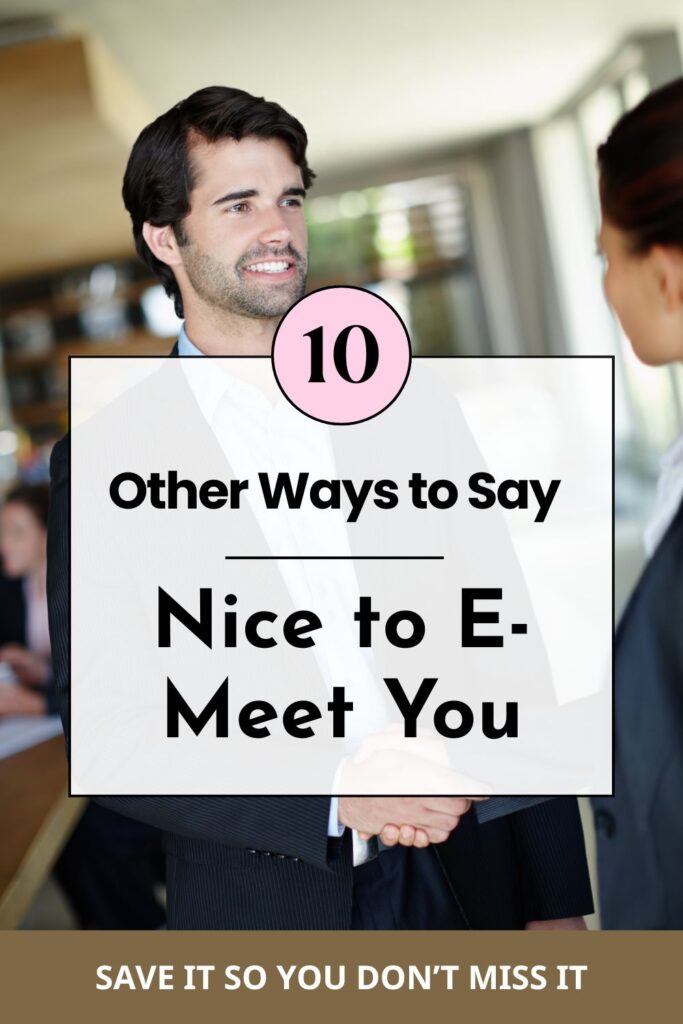
In today’s world, first impressions often happen online. The way you greet someone in a digital space sets the tone for your future conversations. Do you want to come across as enthusiastic? Professional? Friendly? Creative? The words you use can communicate all of that before the other person even replies.
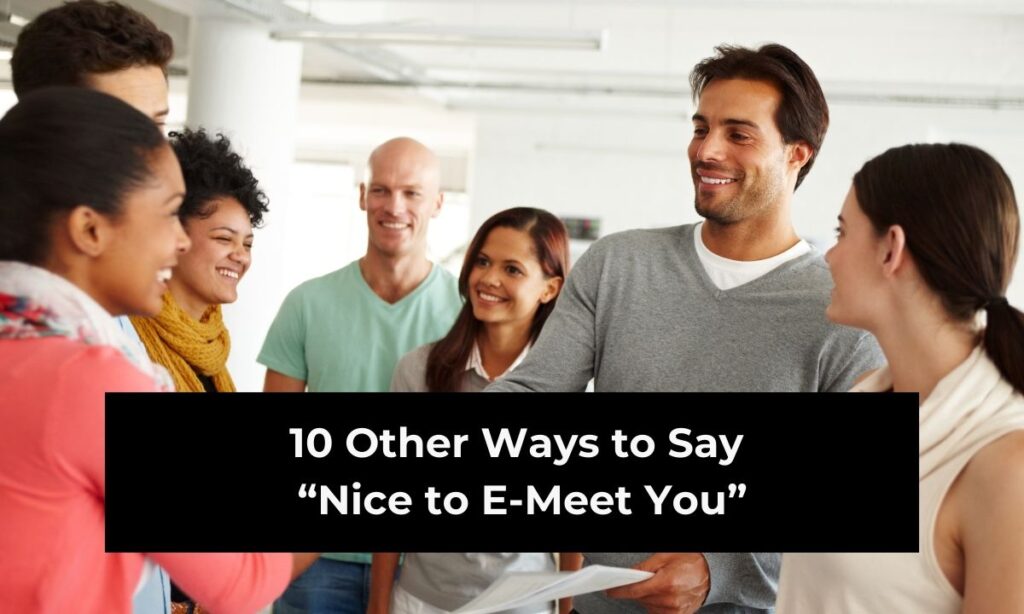
This article will walk you through ten alternatives to “Nice to e-meet you.” Each one is versatile and easy to use, yet feels different enough to help you stand out in your messages. You’ll learn when to use them, why they work, and how they can help you build stronger online connections.
If you’ve ever wondered how to add a little extra warmth and personality to your digital introductions, you’re in the right place. Let’s dive into ten creative and professional ways to say “Nice to e-meet you.”
1. “It’s Great to Connect with You Online”
This phrase strikes a balance between casual and professional. Instead of emphasizing the “e-meet” aspect, you’re focusing on the fact that you’re making a new connection. That subtle shift can feel more natural and less forced, especially in business settings.
You can use this phrase when you’re reaching out on LinkedIn, starting a Zoom meeting, or emailing a new colleague. It works well because it feels positive and intentional. Rather than highlighting that your interaction is virtual, you’re highlighting the value of building a relationship.
For example, you might write in an email: “It’s great to connect with you online. I’ve been looking forward to learning more about your work in digital marketing.” This shows enthusiasm and directs the conversation toward what matters most—your collaboration or shared goals.
The beauty of this phrase is that it’s versatile. You can make it more formal for professional networking or keep it light for casual introductions. Either way, you’re signaling that you value the other person’s time and that you’re glad the connection is happening.
When used thoughtfully, this greeting helps you come across as approachable, engaged, and ready to build a meaningful relationship—even through a screen.
2. “I’ve Heard Great Things About You”
If you want to start on a warm and flattering note, this phrase is perfect. It works especially well when you’ve been introduced by a mutual contact or referred to someone for a professional opportunity. By saying this, you’re acknowledging that you already know something positive about them, which instantly creates goodwill.
For instance, imagine a colleague connects you with a new client. Opening your email with “I’ve heard great things about you, and I’m excited to work together” immediately sets a friendly, respectful tone. It shows that you value their reputation and are genuinely looking forward to the interaction.
This phrase is also effective in situations where credibility matters, such as job interviews, mentorships, or collaborations. It shows that you’ve done your homework and that the introduction isn’t random—you’re entering the conversation with context.
One thing to keep in mind is sincerity. Don’t use this phrase if it isn’t true or if you don’t actually know anything about the person. Authenticity matters in digital communication. If you are genuine, though, it’s a powerful way to break the ice and start a conversation on a positive note.
In short, “I’ve heard great things about you” creates instant trust and makes the other person feel appreciated, right from the very first interaction.
3. “I’m Excited to Collaborate with You”
This alternative is especially powerful in professional contexts where teamwork is involved. It shifts the focus away from just meeting and highlights the purpose of your interaction—working together.
For example, if you’re joining a project with someone new, your email could begin with: “I’m excited to collaborate with you on this campaign. I’ve already seen some of your past work, and I know this is going to be a great partnership.” That not only expresses enthusiasm but also conveys respect for their skills.
This phrase works best when you’re entering a working relationship, whether short-term or long-term. It’s less about small talk and more about aligning on shared goals. Because of that, it’s a great fit for professional settings such as business partnerships, team projects, or consulting relationships.
The tone here is proactive—it doesn’t just acknowledge the connection; it sets a direction for it. You’re saying, “I’m ready to get started,” which can help establish momentum right away.
By using “I’m excited to collaborate with you,” you communicate that you value teamwork, appreciate the opportunity, and see potential in the relationship. That energy can make a big difference in how your new partner perceives you.
4. “I’ve Been Looking Forward to This”
Sometimes, anticipation is the best way to start a conversation. Saying “I’ve been looking forward to this” communicates that you’ve been eagerly waiting for the chance to meet, even virtually. It adds a sense of enthusiasm and positivity that feels personal.
This phrase is great for virtual meetings, interviews, or scheduled networking calls. For example, you could say at the start of a Zoom chat: “I’ve been looking forward to this conversation. Your experience in content strategy is something I’ve been excited to learn more about.” That signals genuine interest and sets a friendly tone.
What makes this phrase effective is its emotional warmth. It doesn’t just acknowledge the meeting—it shows that you care about it. This kind of message helps the other person feel valued and respected, which can strengthen the connection from the start.
It also works well in both professional and casual settings. Whether you’re meeting a potential mentor or joining a virtual book club, “I’ve been looking forward to this” communicates appreciation for the other person’s time.
By using this greeting, you’re setting up the conversation as something meaningful, not just another item on your calendar. That makes the interaction more engaging for both sides.
5. “It’s a Pleasure to Be Introduced”
This option leans slightly more formal, making it a great choice for professional or academic settings. It’s polite, respectful, and carries a timeless quality that works in almost any situation.
For instance, if someone connects you via email, you could reply with: “It’s a pleasure to be introduced, and I look forward to discussing how we might collaborate.” This approach shows gratitude for the introduction while keeping the tone professional and optimistic.
“It’s a pleasure to be introduced” is especially effective when a third party has facilitated the connection. It acknowledges that an introduction has been made and that you’re appreciative of it. That extra touch of formality can go a long way in making you sound polished and considerate.
This phrase also works well in industries where etiquette and professionalism are emphasized, such as law, finance, or academia. It helps you make a respectful impression without sounding outdated or overly stiff.
By choosing this phrase, you’re framing the interaction as a privilege. That makes the other person feel respected and sets the stage for a professional, constructive relationship.
6. “I’m Glad We Could Finally Connect”
In today’s fast-paced digital world, coordinating schedules can take time. This phrase acknowledges that reality while expressing happiness that the meeting is happening now. It’s warm, relatable, and puts both people at ease.
You might use it in an email like this: “I’m glad we could finally connect. I’ve been eager to learn more about your work, and I’m excited about what we might accomplish together.” This makes the conversation feel like the start of something worthwhile.
The phrase works especially well when a meeting has been postponed, rescheduled, or when you’ve been waiting a while for the introduction. It shows patience, understanding, and genuine enthusiasm once the connection is made.
It’s less formal than some other options, making it a good fit for casual professional interactions. At the same time, it’s still polite and professional enough to use in most business contexts.
By using “I’m glad we could finally connect,” you’re showing that you value the person’s time and that you’re happy the interaction is happening now. It’s a friendly way to start a conversation that acknowledges effort and sets a positive tone.
7. “Thanks for Taking the Time to Connect”
Gratitude is always a great way to begin a new interaction. This phrase expresses appreciation while acknowledging that the other person made an effort to meet with you. It creates a courteous and respectful atmosphere from the start.
For example, you could write: “Thanks for taking the time to connect. I know your schedule is busy, and I appreciate the opportunity to speak with you.” That recognition goes a long way in showing respect and professionalism.
This phrase is especially effective in situations where you’re meeting someone in a higher position, such as a mentor, hiring manager, or industry expert. By thanking them, you’re acknowledging the value of their time and expertise.
The tone here is humble and professional. It communicates that you’re not taking the introduction for granted, and you’re genuinely grateful for the opportunity. That humility can help you build credibility and trust quickly.
By leading with gratitude, you set the tone for a positive and respectful conversation, which can make the rest of the interaction flow more smoothly.
8. “I’m Looking Forward to Learning from You”
This phrase is particularly effective in mentorship, educational, or professional development contexts. It highlights your openness to growth and signals respect for the other person’s expertise.
For instance, you might write in a networking email: “I’m looking forward to learning from you and gaining insights into how you approach leadership in your field.” This frames the interaction as a valuable opportunity, not just a casual meeting.
What makes this phrase powerful is that it shifts the focus onto the other person. Instead of centering the interaction on yourself, you’re acknowledging their knowledge and expressing excitement to gain from it. That humility and respect can help strengthen the relationship from the start.
It’s also versatile enough to be used in professional introductions, online workshops, or virtual mentorship programs. In each case, it communicates eagerness, respect, and openness.
By using “I’m looking forward to learning from you,” you’re setting yourself apart as someone who values knowledge and respects expertise. That mindset makes a lasting impression in professional and academic circles alike.
9. “Happy to Be Connected”
This phrase is short, simple, and to the point. It’s less formal than some of the other options, making it ideal for quick introductions on platforms like LinkedIn or casual emails.
For example, you might send a message saying: “Happy to be connected! I’ve enjoyed following your work, and I’m glad we now have the chance to interact more directly.” It’s friendly, approachable, and easy to use in almost any situation.
“Happy to be connected” works because it focuses on the outcome of the introduction rather than the process. You’re not emphasizing that the meeting is virtual—you’re simply expressing satisfaction that the connection exists.
This phrase works especially well in networking contexts where brevity is appreciated. It’s polite but not overly formal, making it suitable for casual professional environments.
By keeping things simple and upbeat, you come across as approachable and easy to engage with. That makes it a great choice for building new relationships without overcomplicating your message.
10. “I Appreciate the Introduction”
Ending on a note of gratitude, this phrase is perfect when someone has facilitated the meeting or when you want to acknowledge the effort that went into making the connection happen. It’s professional, respectful, and versatile.
For instance, if a colleague introduces you to a potential collaborator, you might say: “I appreciate the introduction and look forward to seeing how we can work together.” This makes the other person feel valued while also showing gratitude toward whoever connected you.
This phrase works well in professional settings where relationships and referrals matter. It communicates humility, professionalism, and genuine appreciation.
What makes it especially effective is that it doesn’t just focus on the meeting—it acknowledges the people and effort behind it. That adds an extra layer of respect to your introduction.
By using “I appreciate the introduction,” you demonstrate professionalism and gratitude in a way that makes others more inclined to build a lasting relationship with you.
Conclusion
In today’s digital world, first impressions often happen online. Using the same phrase over and over—like “Nice to e-meet you”—can make your introductions feel generic. By exploring alternative expressions, you show creativity, warmth, and respect, which can help you stand out and build stronger relationships.
Each of the phrases in this list offers something different. Some lean professional, others are casual, and a few emphasize gratitude or enthusiasm. The key is choosing the one that best fits your context and communication style.
Remember, introductions are more than just polite formalities—they’re the foundation for meaningful connections. By choosing the right words, you set the tone for collaboration, networking, or friendship.
So next time you’re about to type “Nice to e-meet you,” pause and consider one of these ten alternatives. A small change in wording can make a big difference in how your message is received, helping you build more genuine, impactful connections.
FAQs
1. Why should I avoid saying “Nice to e-meet you”?
Because it’s overused, it can sound generic or impersonal. Using alternatives helps you stand out and show more personality.
2. Can I still use “Nice to e-meet you” in emails?
Yes, it’s not wrong to use it—it’s polite and acceptable. But if you want to make a stronger impression, alternatives can be more effective.
3. Which alternative is best for professional settings?
Phrases like “It’s a pleasure to be introduced” or “Thanks for taking the time to connect” are great choices for formal or professional contexts.
4. What about casual introductions?
In more relaxed settings, phrases like “Happy to be connected” or “I’m glad we could finally connect” work perfectly.
5. How do I choose the right phrase?
Think about your audience and the context. If professionalism is key, lean toward formal options. If you want warmth and friendliness, choose something more casual.
